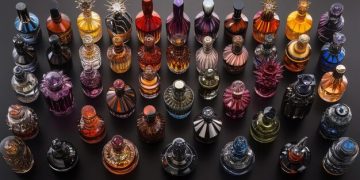Navigating Fragrance Reformulations in 2025: Spotting Changes & Finding Alternatives

Navigating Fragrance Reformulations: How to Spot Changes and Find Alternatives in 2025 requires understanding ingredient shifts, recognizing subtle scent alterations, and exploring alternative fragrances that maintain a similar olfactory profile when your favorite scent changes.
The world of fragrance is constantly evolving, and with it comes the inevitable phenomenon of fragrance reformulations. Navigating Fragrance Reformulations: How to Spot Changes and Find Alternatives in 2025 will equip you with the necessary knowledge and tools to understand, identify, and adapt to these changes, ensuring you always have access to scents you love.
Understanding Fragrance Reformulations
Fragrance reformulations are alterations made to a perfume’s original formula. These changes are often driven by various factors, including ingredient availability, cost considerations, and regulatory compliance. Understanding why these reformulations occur is the first step in navigating the changing landscape of fragrance.
Reasons for Reformulation
Several reasons contribute to fragrance reformulations, and it’s helpful to be aware of them.
- Ingredient Availability: Natural ingredients, such as certain types of sandalwood or oakmoss, may become scarce or restricted due to environmental concerns or over-harvesting.
- Cost: The prices of raw materials fluctuate. Manufacturers may reformulate to keep production costs manageable.
- Regulations: Regulatory bodies like the International Fragrance Association (IFRA) impose restrictions on certain ingredients due to potential allergens or other health concerns.
- Market Trends: Consumer preferences and market trends can also drive reformulations. Brands may try to update a fragrance to appeal to a broader audience.
Reformulations are a common practice in the fragrance industry, and while sometimes they are subtle, other times they can significantly change the character of a beloved scent. This change can lead to disappointment among loyal customers who have cherished a particular fragrance for years.

Identifying Reformulations: What to Look For
Spotting a reformulation can be challenging, but there are several clues that can tip you off. By paying attention to these signs, you can better determine if your favorite fragrance has undergone changes.
Changes in Packaging and Labeling
One of the first indicators of a reformulation can be changes to the packaging or labeling. Look closely for differences in the bottle design, label text, or even the box itself.
Often, brands will subtly update the packaging to reflect a change in the formula. This could include changes in font, color schemes, or the inclusion of new disclaimers or information. Keep an eye out for phrases like “new and improved” or “revised formula,” which are clear giveaways.
Subtle Scent Alterations
The most obvious way to identify a reformulation is through scent. However, it can be subtle, and our perception can be influenced by various factors. Comparing new and old bottles side-by-side helps.
- Top Notes: Pay attention to the initial burst of scent. Reformulations often affect the top notes first, altering the initial impression of the fragrance.
- Mid Notes: The heart of the fragrance, the mid notes, might smell different. Look for changes in the balance of floral, spicy, or fruity elements.
- Base Notes: The base notes provide the foundation and longevity of the scent. If the dry-down smells weaker or different, it could indicate a reformulation.
- Longevity: A significant reduction in the fragrance’s staying power is a common sign of reformulation.
Identifying reformulations requires a keen sense of smell and careful attention to detail. Over time, you may find it easier to detect these subtle shifts in fragrance composition.

The Impact of Ingredient Changes
The ingredients used in a fragrance are crucial to its overall character. When these ingredients change, it can significantly affect the scent profile and performance. Understanding these impacts is important for those navigating fragrance reformulations.
Key Ingredients and Their Substitutes
Certain ingredients are more prone to replacement due to cost, availability, or regulatory reasons. Understanding these substitutions can help you anticipate changes in your favorite fragrances.
- Natural Oakmoss: Often replaced with synthetic versions to comply with IFRA regulations.
- Sandalwood: Due to over-harvesting, natural sandalwood is frequently substituted with synthetic alternatives.
- Ambergris: A rare and expensive ingredient, often replaced with synthetic amber accords.
How Ingredients Affect Scent Profile
Each ingredient plays a specific role in creating the overall scent profile of a fragrance. These individual components blend together to create the unique and memorable scents that we cherish.
The top notes, for example, are responsible for the initial impression of the fragrance. These lighter molecules evaporate quickly but make a distinct impact. Common top notes include citrus, herbs, and light fruits. When reformulations change or remove these ingredients, the opening of the fragrance can feel very different.
Exploring Alternative Fragrances
When a beloved fragrance is reformulated, a natural response is to seek alternatives that capture a similar essence. Exploring different fragrances can be a rewarding experience, allowing you to discover new favorites that evoke similar emotions and memories.
Identifying Similar Scent Profiles
The fragrance wheel is a tool that helps categorize and relate different scents based on their dominant characteristics. This system is particularly useful for identifying fragrances with similar profiles to your reformulated favorites.
Floral, Oriental, Woody, and Fresh are some of the main categories which are further divided into more specific subcategories. For example, if you enjoy a fragrance with a strong rose note, finding other perfumes within the floral category is a good starting point.
Resources for Finding Dupes and Alternatives
Fortunately, numerous online resources and communities are dedicated to helping fragrance enthusiasts find dupes and alternatives.
- Fragrantica: A comprehensive online encyclopedia of perfumes, offering detailed information on notes, accords, and user reviews.
- Parfumo: Another extensive database with fragrance information and community forums.
- Reddit (r/fragrance): A lively community where users share recommendations and discuss reformulations.
The experience of finding alternatives can be a positive journey, opening the door to exciting new scents and expanding your olfactory horizons.
Staying Informed About Industry Changes
The fragrance industry is dynamic, with continuous changes in regulations, ingredient availability, and consumer preferences. Staying well-informed about these changes can help you anticipate and navigate reformulations effectively.
Following Industry News and Blogs
Following industry news and blogs is an excellent way to stay informed about the latest developments in the fragrance world. These resources provide insights into new regulations, ingredient trends, and reformulation practices.
Joining Online Fragrance Communities
Online fragrance communities are a valuable resource for staying informed and connecting with fellow enthusiasts. These communities offer a space to discuss reformulations, share information, and seek recommendations.
Staying connected with these communities ensures you’re always in the loop, ready to adapt to any changes in the fragrance landscape.
Building a Fragrance Wardrobe
Building a diverse fragrance wardrobe can provide a sense of security and flexibility when dealing with reformulations. Having a variety of scents to choose from ensures you are not solely dependent on a single fragrance that might change over time.
Understanding Your Personal Preferences
The first step in building a well-rounded fragrance wardrobe is understanding your personal preferences. What types of scents do you gravitate towards? What notes do you enjoy? Reflecting on these questions can guide your purchasing decisions.
Diversifying Your Scent Collection
Once you understand your preferences, it’s time to diversify your collection and consider scents from different fragrance families. Try to include scents from different categories to have options for every occasion and mood.
Building a fragrance wardrobe is an ongoing process, a journey of continuous exploration and discovery. Embrace this adventure and enjoy finding new scents that resonate with you.
| Key Point | Brief Description |
|---|---|
| ⚠️ Ingredient Scarcity | Natural resources deplete, forcing reformulation with synthetics. |
| 🧪 Regulatory Changes | IFRA restricts ingredients, leading to formula adjustments. |
| 👃 Scent Alterations | Top, mid, and base notes can shift post-reformulation, changing its quality. |
| 🔍 Packaging Clues | Check for “new formula” labels or bottle design updates indicating change. |
Frequently Asked Questions
▼
Fragrance reformulations occur due to several factors, including the scarcity or increased cost of ingredients, regulatory changes like IFRA restrictions, and shifts in consumer preferences.
▼
Look for changes in packaging and labeling, and be mindful of subtle scent alterations, especially in the top, mid, and base notes. Also, check if the fragrance’s longevity has changed.
▼
Ingredients are essential because they can change the scent profile and performance. Replacing a key ingredient can affect the overall character of the fragrance, resulting in notable differences in scent.
▼
Websites like Fragrantica and Parfumo are excellent resources for fragrance information and user reviews. Social media communities like Reddit can also provide recommendations for dupes and alternatives.
▼
Following industry news and blogs and joining online fragrance communities can help you stay informed about changes, like regulation updates, and prepare for substitutions that might affect your favorites.
Conclusion
Navigating Fragrance Reformulations: How to Spot Changes and Find Alternatives in 2025 involves staying informed, adapting to changes, and embracing new olfactory experiences. By understanding the reasons behind reformulations, learning to identify subtle scent alterations, and exploring potential alternatives, you can continue to enjoy the world of fragrance with confidence and curiosity.





